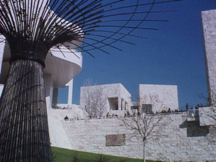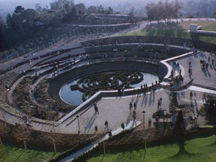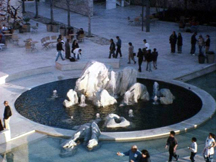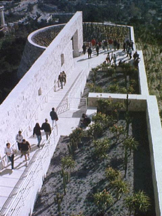
I've got a concept
September 5, 1999
Copyright 1999 Douglas E. Welch

| Subscribe to AGN |
 Last weekend the family headed off to what has been described
as a new Acropolis in Los Angeles, the new Getty Center. We had been there twice before but it was our opportunity to
act as host to two other couples who hadn’t yet braved the crowds.
Thankfully the crush of people has greatly abated and you can
spend the entire day without feeling as if someone was about to
push you off one of the many high terraces.
Last weekend the family headed off to what has been described
as a new Acropolis in Los Angeles, the new Getty Center. We had been there twice before but it was our opportunity to
act as host to two other couples who hadn’t yet braved the crowds.
Thankfully the crush of people has greatly abated and you can
spend the entire day without feeling as if someone was about to
push you off one of the many high terraces.
Along with the art and architecture of the center one of the major features is a very large garden complete with winding path, waterfalls, streams and a variety of interesting plantings. Each time I visit the Getty Garden I am a bit intimidated by all the grand planning and high concept surrounding the garden. I can’t help but compare it to my own small patch of green. Silly, I know, especially since mine cost nearly nothing and theirs ran into millions of dollars. I would imagine the upkeep alone runs into the tens of thousands per year.
 Unlike our gardens, the Getty garden grew from a concept, not
from a seed. Sure, there are literally thousands of plants and
tons of soil were moved around but nothing happened until the
concept, the plan, the idea was firmly imprinted on paper. While
we all do a little garden planning, the attention devoted to the
Getty Garden borders on the obsessive. It should be no surprise
that sometimes the garden comes off as calculated and a bit over-manipulated.
I enjoy visiting but can’t help feeling in the back of my mind
that my attention is being a bit too directed from one element
to the next.
Unlike our gardens, the Getty garden grew from a concept, not
from a seed. Sure, there are literally thousands of plants and
tons of soil were moved around but nothing happened until the
concept, the plan, the idea was firmly imprinted on paper. While
we all do a little garden planning, the attention devoted to the
Getty Garden borders on the obsessive. It should be no surprise
that sometimes the garden comes off as calculated and a bit over-manipulated.
I enjoy visiting but can’t help feeling in the back of my mind
that my attention is being a bit too directed from one element
to the next.
 The Getty Garden also reminds me of the difference between garden
as habitat and garden as show-piece. I shudder at the thought
of bringing a garden tour through my back yard but gain much enjoyment
in private or with my friends. My garden is what it is and offers
no grand concept, merely a habitat where people can live out a
small part of their lives. The Getty garden is designed for public
consumption and this puts many constraints on its design and execution.
The Getty Garden also reminds me of the difference between garden
as habitat and garden as show-piece. I shudder at the thought
of bringing a garden tour through my back yard but gain much enjoyment
in private or with my friends. My garden is what it is and offers
no grand concept, merely a habitat where people can live out a
small part of their lives. The Getty garden is designed for public
consumption and this puts many constraints on its design and execution.
One of the first things you notice as you enter the Getty Garden are the expansive, perfectly groomed lawns. Unfortunately, a lot of energy is expended in keeping people off the grass. It seems a bit silly to include such an enticing feature and then tell the public they can only look at it. It seems obvious that, regardless of age, people want to run barefoot through the grass and roll down the gentle slopes.
 Another problem is that of stasis. While our gardens change from
day to day and moment to moment, the Getty Garden, and other gardens
based heavily on a concept are determined to stay the same year
after year. After spending million of dollars on their design
it would be foolish to change into something else. Of course,
perhaps that is just what they ought to do. Maintaining a garden
in stasis keeps the concept but it fights against nature instead
of embracing it. To me, it is the difference between looking at
Monet’s beautiful paintings of his garden and visiting the garden
itself. The paintings are wonderful in their own right but they
are no substitute for a living, breathing garden.
Another problem is that of stasis. While our gardens change from
day to day and moment to moment, the Getty Garden, and other gardens
based heavily on a concept are determined to stay the same year
after year. After spending million of dollars on their design
it would be foolish to change into something else. Of course,
perhaps that is just what they ought to do. Maintaining a garden
in stasis keeps the concept but it fights against nature instead
of embracing it. To me, it is the difference between looking at
Monet’s beautiful paintings of his garden and visiting the garden
itself. The paintings are wonderful in their own right but they
are no substitute for a living, breathing garden.
Of course, without the excess of money and concept we can plan our own garden with abandon. We can adapt, adjust and re-configure as the mood and the mood of our plants strikes us. The next time you visit a show-piece garden, take what you can, enjoy as much as possible and return to your garden with a renewed enjoyment of what it means to be a gardener.
Douglas
Building the Getty
Richard Meier / Hardcover / Published 1997
The Getty Center : Design Process
Bill Lacy, et al / Paperback / Published 1991
The Getty Center : Design Process, Making Architecture
Harold M. Williams / Hardcover / Published 1997
The Getty Center : Richard Meier & Partners (Architecture in Detail
Series)
Richard Meier, Michael Brawne / Paperback / Published 1998
Going to the Getty : A Book About the Getty Center in Los Angeles
Vivian Walsh(Contributor), J. Otto Seibold / Hardcover / Published
1997
Making Architecture : The Getty Center
Harold M. Williams, et al / Paperback / Published 1997
Between Nature and Culture : Photographs of the Getty Center
Mark Johnstone(Introduction), et al / Hardcover / Published 1999
Douglas E. Welch is a freelance writer and comptuer consultant
based in Van Nuys, California.
He can be reached at douglas@welchwrite.com or via his web pages at www.welchwrite.com.